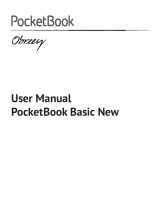
Technical Specications
Display
6” E Ink® Vizplex 600×800,
166 dpi, B&W
CPU 800 MHz
RAM 128MB
Storage 2GB *
Operating system Linux®
Communications
USB 2.0
Wi-Fi (802.11 b/g/n)
Memory slot MicroSD/SDHC (up to 32 GB)
Battery Li-Polymer, 3.7 V, 1000 mAh **
Book formats
PDF, EPUB (including DRM-protected);
TXT, FB2, FB2.zip, RTF, HTML, HTM, CHM,
DJVU, DOC, DOCX, TCR, PRC, TCR
Image formats JPEG, BMP, PNG, TIFF
Dimensions 122.6×176.38×9.7 mm
Weight 175 g
* The actual available internal storage size may vary depending on the software
conguration of your device.
** Battery life and values mentioned above might vary depending on usage mode,
connectivity and settings.























